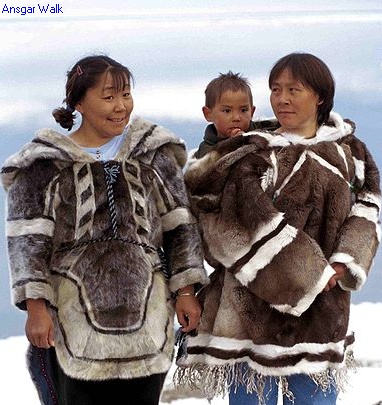Big Blog II: The Final One :')
Hey everybody... *sheds a tear* it's our last blog together. It has been so fun reading everyone's blogs and I will certainly miss the funny commentary and stories. So, to honor our last hoorah, I have decided to send us out with the Inuit peoples of Alaska.
Now I know what you're thinking, what kind of send-off is that? And honestly, I don't have an answer, I just thought it was cool. So grab a blanket, steal a snack, and get ready for some serious throat-singing.
The Inuit people, or stereotypically known as the Eskimo people, are a group of Native Americans that live along the coldest regions of the Alaskan coast. Their culture is primarily based around hunting (there's not much gathering/farming because IT'S TOO FREAKING COLD TO GROW ANYTHING) whales, caribou, and other Arctic animals. The music of the Inuit is fairly simplistic, contrary to their southern neighbors in the Northern United States region (tribes that we studied in class). They have two drums that are the most common in much of the music they perform: the round drum and the rectangle drum. I know, very hard to remember.
The round drum is made with whale or caribou stomach for the head, and wood for the frame. This type of drum does not have a bottom, and is waved up and down while playing to produce a whooshy-like sound. As you can see in the video I have attached below, the round drum is played by hitting a mallet on the frame instead of the head as we have seen in many other cultures.
Onto the main event: Inuit Throat-singing! I don't know if any of you have seen that girl on tiktok that sings with her mom, but her username is @shinanova and she posts some really good stuff. Her mom is her vocal coach and they are both professional Inuit throat-singers, and I am just obsessed with them. Shina inspired me to make this my blog topic because her content is just sooooo beautiful and I highly suggest you take a look. (I have also put in a video below because I love her)
But anyways, back to what I was saying...
Throat-singing does not sound like what you think it would; singers use their throats to make sounds instead of their vocal cords. This technique produces a much raspier sound with intense emotion from the singers themselves and instrumentalists that accompany them. Usually drummers and background vocalists will join in for support and it totally changes the vibe of the performance. Here is a compilation of Shina and her mom practicing, singing, and using other techniques of throat-singing. There's even some captions to help you understand what's happening.
Now that we've talked about some of the musical aspects of the Inuit culture, let's talk about traditional dress used in the ceremonies and rituals we've talked about. Since the Inuit people live in the very cold temperatures of Alaska, the clothing seen there is almost always made from very thick and heavy animal pelt or fur. The Inuit get most of their food from hunting, and in an effort/necessity to use all parts of the animal, the pelt or fur is made into jackets, pants, boots, etc.

In the picture above, you can see the two women wearing parkas most likely made from reindeer, caribou, and/or bear pelt. Now this is just everyday dress, the fancy stuff is much more appealing.

In this image, you can see more colors, beading, embroidery happening. These parkas and dresses are worn on special occasions or performances. Natural dyes and beads are used to give these garments their colorful personalities, but they also hold stories within their designs. Each pattern means something different to the individual or their tribe. The woman on the left has small yellow fish on her coat, signifying a name or story that is special to her or her people.
You can read more about all of this from the blog I found here, the author has some really cool sources that I also ventured into for fun.
Thank you for joining me on the journey of Spring semester 2022, it's been real guys. Hope to see you around.
Grace,
ReplyDeleteI’d done a tangentially related topic (throat singing but on Tuva), so it was extra neat to read your blog post! I’m glad to learn that the proper name for the people of this region would be the Intuit people and that the term “eskimo” has been a bit more stereotypical. I stopped in my tracks when I first read “rectangle drum” and was certainly not disappointed by what followed. One of my favorite details from the whole post was definitely learning that regular drums are both hung from the ceiling and hit from below. Thank you for sharing, and I hope you have a good end to your semester!
Cara
hey buam you wrote a great blog becasue i learned lots of new things about alaska culture. i liked reading the part with what they wear and i found it very intresting.
ReplyDeleteI learned so many cool things from this blog! It was sad doing our last blog :( I've never heard of the concept throat singing before and I was hoping someone would pick that topic off the list, so that I could learn about it. Also I think it was cool about the designing of the instruments out of whale.
ReplyDeleteThis was yet another cool blog. Alaska is a culture that is separated from my mind. Throat singing is a very interesting way to express yourself. I wonder how in the world people discovered this type of expression.
ReplyDeleteI learned so much from this blog! I had little to no knowledge about the inuit people or alaskan culture. I think my favorite thing that I learned was the throat singing video, it's unlike anything i've heard before.
ReplyDelete